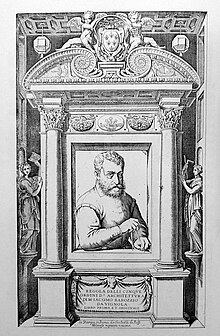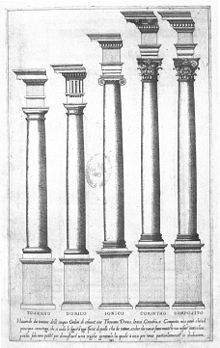Giacomo Barozzi da Vignola
Giacomo Barozzi da Vignola , also Jacopo Barozzi da Vignola or simply Vignola (born October 1, 1507 in Vignola near Modena , † July 7, 1573 in Rome ) was an Italian architect of the late Renaissance in the 16th century. His two great masterpieces are the Palazzo Farnese in Caprarola and the Jesuit church Il Gesù in Rome.
Life
Trained as a painter and perspective draftsman in Bologna , his first commissions included templates for inlay work . In 1536 he traveled to Rome to make precise drawings of the Roman temples, with the ulterior motive of publishing an illustrated Vitruvius . He was later called to Fontainebleau by King Francis I of France , where he spent the years 1541 to 1543. In Rome, where he was accepted by the Farnese , he worked with Michelangelo , who greatly influenced his style. From 1547 Vignola continued the construction work on the Palazzo Farnese in Rome. From 1564 Vignola worked on St. Peter's Basilica and constructed the two subordinate vaults according to Michelangelo's plans. His influence can also be felt in the work of Carlo Maderno on the facade of the cathedral.
In 1573 he designed Sant'Anna dei Palafrenieri as a uniform, elongated oval room, another prototype of the baroque church building.
His main literary work is the architectural theory textbook "Regola delle cinque ordini d'architettura" (rules of the five orders of architecture) from 1562, in which he endeavored to standardize architectural elements in a fixed interrelation of numbers. His perspective theory, "Le due regole di prospettiva pratica" (Two rules of practical perspective - Bologna 1583), left unfinished in 1573, contains his biography. Vignola presented practical applications without theoretical ambiguities, which were understandable and implementable. This made Vignola one of the three authors, alongside Serlio and Palladio , who spread the Italian style across Europe.
In Germany , for example, the editing of his standard work Basic Rules on The Five Pillars by the Saxon engineer and architect Johann Rudolph Fäsch (1680–1749), illustrated by the engraver Johann Christoph Weigel and published in large numbers over a century from around 1720, influenced generations of architects.
Vignola is buried in the Pantheon in Rome.
Other works
- Palazzo Bocchi, Bologna (1545)
- Spiral staircase in Palazzo Isolani , Bologna
- The Tribuna in San Petronio in Bologna (1547/48)
- Palazzo dei Banchi , Bologna (1565–1568)
- The Villa Giulia for Pope Julius III. , where he worked with Giorgio Vasari (1550–1555)
- The Palazzo Farnese in Caprarola (1559–1573)
- The Fontana Papacqua in Soriano nel Cimino (1562)
- The Villa Lante in Bagnaia (from 1566) including the gardens, the water features and the casini
- The church Il Gesù in Rome, the mother church of the Jesuits, whose basic structure became groundbreaking for the baroque churches of the 17th century
- The Church of Sant'Andrea in Via Flaminia in Rome, the first elliptical sacred building, also a “signature” of the Baroque
Publications
- List of his books and translations - "Architectura", Center d'études supérieures de la Renaissance, Tours
literature
- Ignazio Danti : Le due regole della prospettiva pratica . ( limited preview in Google Book search).
- Johann-Karl Schmidt : On Vignola's Palazzo Bocchi in Bologna , in: Communications from the Kunsthistorisches Institut in Florenz , XIII, 1967.
- Miguel Ángel Cajigal Vera: Proportion, Symmetry and Mathematics in the Renaissance Theory of Construction: Vignola's Treaty of Architecture and its Musical Mirror (PDF). In: Karl-Eugen Kurrer , Werner Lorenz , Volker Wetzk (eds.): Proceedings of the Third International Congress on Construction History. Neunplus, Berlin 2009, ISBN 978-3-936033-31-1 , pp. 283-288
Web links
- Jacopo Barozzi from Vignola - Short curriculum vitae (English) via Museo Galileo
- Paolo Zauli: JACOPO BAROZZI FROM VIGNOLA Life and Work ( Memento of February 21, 2005 in the Internet Archive ) (English, about Vignola from a Bolognese perspective)
- Gardens designed by Giacomo Barozzi da Vignola (Eng., Vignola's influence on garden design)
Individual evidence
- ↑ Die kleine Enzyklopädie , Encyclios-Verlag, Zurich, 1950, Volume 2, page 854
- ^ Des Jacobi Barozzi von Vignola basic rules on the five columns. - Auffs new to the most industrious overlooked, increased with different necessary rules, and explained with 50 cracks in Kupffer / by Johann Rudolph Fäsch, Architectum. Sr. Königl. Maj. In Pohlen and Thür. Fürstl: Durchl: Zu Sachsen, engineer captain, Nuremberg approx. 1720; Saxon State Library State and University Library Dresden
- ^ Ferruccio Canali: progetti commissionati dalla famiglia Boncompagni
| personal data | |
|---|---|
| SURNAME | Barozzi da Vignola, Giacomo |
| ALTERNATIVE NAMES | Barozzi da Vignola, Jacopo; Vignola |
| BRIEF DESCRIPTION | Italian architect (baroque) |
| DATE OF BIRTH | October 1, 1507 |
| PLACE OF BIRTH | Vignola near Modena |
| DATE OF DEATH | July 7, 1573 |
| Place of death | Rome |




